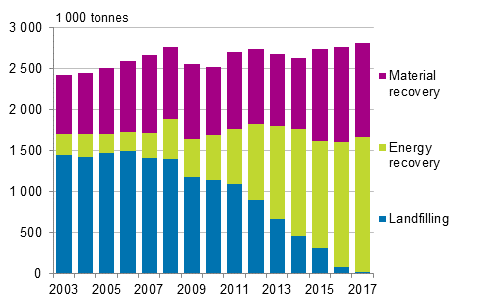Published: 9 January 2019
Amount of municipal waste has not grown and recovery has replaced disposal at landfill sites
Corrected on 11 January 2019. The corrections are indicated in red.
In 2017, the total amount of municipal waste was 2 811 589 tonnes. The amount has remained at the same level as in the last few years.
Disposal of municipal waste at landfill sites has decreased strongly according to the prevailing development in recent years. In 2017, only around one per cent of municipal waste was disposed at landfill sites. It has been replaced by recovery of waste: both energy production and material recovery are competing for the recovery of former landfill waste. Recovery of municipal waste as energy has in recent years been the predominant recovery method.
Amount of municipal waste by treatment method in 2003 to 2017 (Corrected on 11. January 2019)

The use of municipal waste as a fuel for district heat production of built-up areas has become established and its role has grown there. Organic components included in energy-recovered municipal waste also curb greenhouse gas emissions in case they replace the use of fossil fuels.
Amount of separately collected municipal waste has grown
Slightly less municipal waste than before ends up in material-specific separate collection and through it to recycling. However, plastic, wood, paper and paperboard containing mixed components are also collected for energy recovery and are separated from other municipal waste. If we add up separately collected or separated waste components for recycling and energy recovery, the amount of waste separated from mixed waste into recovery has grown.
In 2017, around 99 per cent of municipal waste was recovered, which is more than ever before. The share of material recovery fell to 41 per cent, but the share of energy recovery went up to 58 per cent. The material recovery rate is high particularly for fibre packaging and other collected fibre. Most of biowaste is composted or digested, in total around 370,000 tonnes. The digestion residue is used in soil improvement or landscaping, as is compost soil.
Total amount of municipal waste per inhabitant has stabilised
The growth in the amount of municipal waste has evened out in recent years, varying between 2.7 and 2.8 million tonnes. Calculated per capita, the amount has stabilised at around 500 kilogrammes a year. In 2017, the ratio grew by a few kilogrammes from the previous year and stood at 510 kilogrammes per capita.
Source: Waste statistics 2017, Statistics Finland
Inquiries: Juha Espo 029 551 3463, Johanna Pakarinen 029-5513313, ymparistotilinpito@stat.fi
Director in charge: Ville Vertanen
Publication in pdf-format (161.6 kB)
- Tables
-
Tables in databases
Pick the data you need into tables, view the data as graphs, or download the data for your use.
Updated 9.1.2019
Official Statistics of Finland (OSF):
Waste statistics [e-publication].
ISSN=2323-5314. Municipal waste 2017. Helsinki: Statistics Finland [referred: 20.4.2024].
Access method: http://www.stat.fi/til/jate/2017/13/jate_2017_13_2019-01-09_tie_001_en.html

